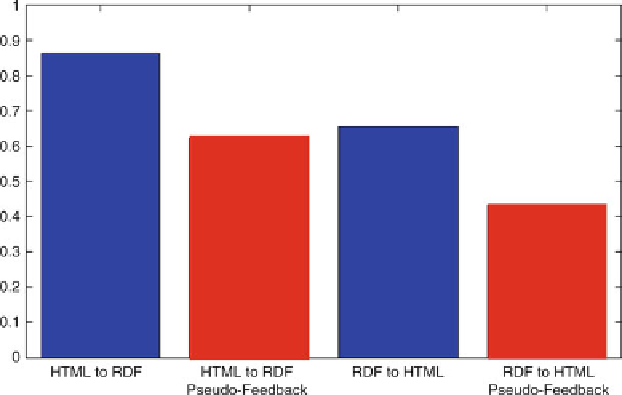Information Technology Reference
In-Depth Information
Fig. 6.12
Comparing relevance feedback to Pseudo-relevance feedback on the Semantic Web
(
RDF
) and hypertext web (
HTML
)
6.7
Inference
In this section the effect of inference on relevance feedback is evaluated by
considering inference to be document expansion. One of the characteristics of the
Semantic Web is that the structure should allow one 'in theory' to discover more
relevant data. The Semantic Web formalizes this in terms of type and sub-class
hierarchies in RDF using RDF Schema (Brickley and Guha 2004). While inference
routines are quite complicated as regards the various Semantic Web specifications,
in practice the vast majority of inference that can be used on the Semantic Web is of
two types (as shown by our survey of Linked Data (Halpin 2009a)),
rdf:subClassOf
that indicates a simple sub-class inheritance hierarchy and
rdf:type
that indicates a
simple type. For our experiment, we followed all explicit
rdf:subClassOf
statements
up one level in the sub-class hierarchy and explicit
rdf:type
links. The resulting
retrieved Semantic Web data was all concatenated together, and then concatenated
yet again with their source document from the Semantic Web. In this way, Semantic
Web inference is considered as
document expansion
.
Inference was first tried using normal relevant feedback, again with the same
best-performing parameters (
tf
with
m
2). In the first case, the
inference is used to expand Semantic Web documents in semantic search, and then
the hypertext results are used as relevance feedback to improve the ranking. How-
ever, as shown in Fig.
6.13
, deploying inference only causes a drop in performance.
In particular, using hypertext Web results as relevance feedback to the Semantic
Web, the system drops from a performance of 0.8611 to a performance of 0.4991
(
p
=
10
,
000 and
ε
=
0
.
<
0
.
05). With pseudo-feedback over the top 10 documents, the performance

Search WWH ::

Custom Search